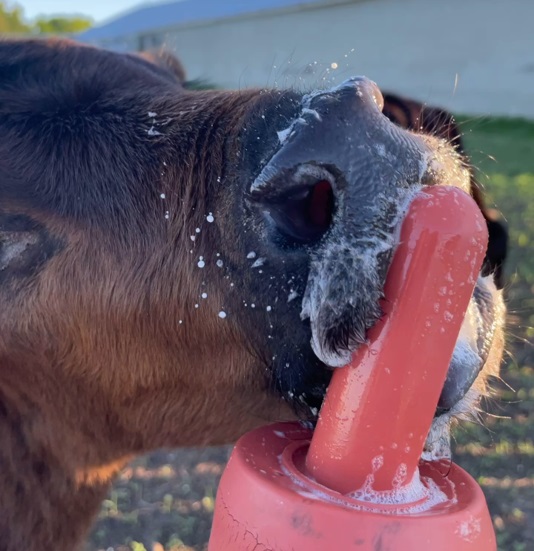What You Need to Know to be a Bottle Calf’s Mama

Listen to a discussion of the content in this article on this episode of the BeefWatch podcast. You can subscribe to new episodes in iTunes or paste http://feeds.feedburner.com/unlbeefwatch into your podcast app.
In the beef industry, the goal is to have each newborn calf paired up with a good cow who has adequate milk and plenty of maternal instincts. Unfortunately, there are times a calf ends up without a mother and becomes a bottle calf.
Getting off to a good start
Colostrum is the first milk produced by a cow and should be consumed by the newborn within the first 24 hours, preferably in the first six hours. It contains immunoglobulins, protein, energy, vitamins, and minerals important to immunity and strength for the newborn. If the calf cannot nurse the cow, and cow’s colostrum is not available, it is important to give the calf a commercial colostrum replacement which contains around 120 g of IgG.
All milk replacers are not created equal
It is most beneficial to select a milk replacer that is whey based and formulated for calves rather than a general all-purpose milk replacer. Mixing the powder thoroughly with water that is 110-120° F improves digestion and absorption for the newborn. If the calf takes two full (4 pint) bottles (total of 8 pints/day) that is sufficient and supplies adequate nutrition. Feeding more only increases cost and slows rumen development and dry feed intake. Small or weak calves may only take a pint or two per feeding and therefore may need to be fed several times a day until a full bottle can be consumed at a feeding.
Having a great relationship with a veterinarian is critical
The bottle calf most likely had a rough start in life resulting in compromised immunity, and is now living in confined quarters, which are typically conducive to increased pathogen loads. This combination can result in a sick calf requiring antibiotics and/or electrolyte treatment. Fortunately, any decrease in appetite or lethargic appearance can be recognized quickly in a calf fed with a bottle twice a day. Having a relationship with a veterinarian who can recommend effective methods of treatment and rapid intervention is critical for the success of the bottle calf.
Development of the rumen in the nursing calf
The calf nursing a cow in a traditional beef operation begins to eat solid feed within the first month of life. The bottle calf needs that same opportunity for proper rumen development. Dairy research has shown that bottle calves receiving hay or long stem forage, along with some concentrates, develop rumen musculature as well as papillae important for rumination, digestion, and absorption. Additionally, the bottle calf needs clean drinking water to help with not only hydration, but with rumen development and appetite.
Providing the Right Feed
Low quality hay is not palatable for the bottle calf and has a slow rate of passage through the digestive system, reducing the overall intake of solid feed. High quality hay such as leafy alfalfa, immature grass hay, or the opportunity to graze growing grass are better options for the bottle calf. Additionally, supplying a good protein source such as dried distillers grains or a starter feed will encourage rumen development and overall growth of the calf. By providing ample and proper concentrates, you can also prevent the bloated-like appearance characteristic of some bottle calves.
How Long Does the Calf Need a Bottle?
A beef calf is usually eating 1-1.5% of its body weight on a dry matter basis by the time it is 10-12 weeks old. A calf eating this much solid feed is likely ready to be weaned off the bottle. However, the digestive system is small, and the nutrient needs are high, therefore the calf needs highly digestible feed that has a high rate of passage so the calf can eat small frequent meals throughout the day as the rumen develops and grows.
Points to Remember
Colostrum or colostrum replacer is very important for the calf to consume within 24 hours of birth. A properly formulated milk replacer can provide the nutrients the calf no longer gets from the cow. By one month of age, the calf needs to be consuming high quality hay or grass, concentrate or creep starter, and water. A veterinary/client relationship will be very beneficial to anyone raising a bottle calf. An orphan calf can thrive on a bottle. Producers may find that selling bottle calves as yearlings is a more profitable system than selling as calves as they generally are behind their peers in growth the first 6-8 months.
Interviews with the authors of BeefWatch newsletter articles become available throughout the month of publication and are accessible at https://go.unl.edu/podcast.
